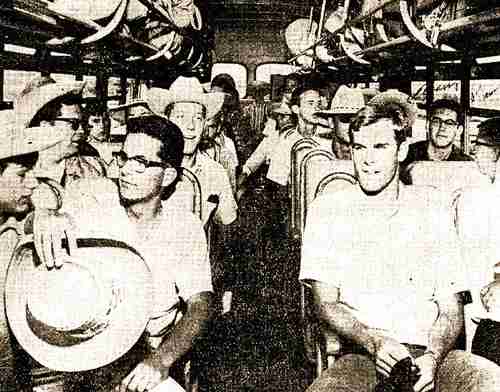▲ Group of students recruited in San Diego to work in Blythe, California, in the melon harvest, in the summer of 1965, in an image originally published in the San Diego Union Tribune.
AND
n July 1965 the strawberries and asparagus were ready to be harvested in the Salinas Valley, California, but there were no workers. It turns out that a year earlier, the United States government had broken off negotiations with Mexico and definitively canceled the Bracero Program, which had operated for 22 years.
Given the shortage of workers, the Ministry of Labor decided to organize a national program to recruit 20,000 students aged 17 and 18 to work in the crops of California, Texas and other states. And just as they chose the braceros, they also selected the students: they discarded the nerds and they opted for athletes and strongmen. They would be paid the minimum wage plus extras for productivity, they would live in wooden barracks and would not be allowed to leave or return to their homes.
The project was called A-TEAM ( Athletes in Temporary Employment as Agricultural Manpower) and was presented to the media at a press conference in Washington.
This is how several trucks arrived in Salinas with boisterous young people happy to have an adventure, who were recruited in Iowa, Kansas and New Mexico. The press reviewed the departure of the boys and at the same time commented that working in the fields, in the fields and close to the ground, required great motivation (for money, exercise or hunger).
The project was a total failure. The first day the athletes ended up exhausted and sunstroke, after three days they were sore, sore, fed up and upset. They complained about everything, the food, the beds, the heat and the miserable salary. Two weeks later they went on strike and went home.
One of the protagonists and witness to the experiment was Randi Carter, who would later be a filmmaker and director in Hollywood, with relative success in several films. He was also a screenwriter and tried to make a film about his experiences in the fields of Salinas, which was accepted twice, but never made.
Several of these boys learned very quickly what it costs to harvest lettuce, asparagus, strawberries and other products where it has not been possible to mechanize the harvest. They also realized, in a few days, that very little was earned for all that work. And yes, the worst salary is paid in agriculture.
This is a shameful episode for the US government, which is incapable of self-criticism, acknowledging and remunerating the work of Mexicans in agriculture. Likewise, it is an episode that was forgotten or hidden and that was revealed in 2016 by the Latin historian Lori A. Flores in her award-winning book. Grounds for Dreaming: Mexican Americans, Mexican Immigrants, and the California Farmworker Movement.
That was half a century ago and the matter seems like something out of a movie, whoever takes it up remains pending.








